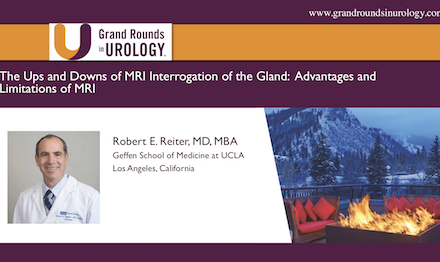Kirsten L. Greene, MD, MAS, FACS, presented “Updates in mpMRI” during the 21st Future Directions in Urology Symposium in August 2021 in Charlottesville, Virginia.
How to cite: Greene, Kirsten L. “Updates in mpMRI.” August 2021. Accessed Jul 2024. https://grandroundsinurology.com/updates-in-mpmri/
Updates in mpMRI – Summary
Kirsten L. Greene, MD, MAS, FACS, the Paul Mellon Professor and Chair of Urology at the University of Virginia School of Medicine, gives an update on multiparametric (mp) MRI’s current role in prostate cancer detection, surveillance, staging, and recurrence. She defines mpMRI as featuring diffusion weighted images and being dynamic contrast enhanced (DCE), but also notes that biparametric MRI, which omits DCE, appears to be an effective option as well. Dr. Greene goes over the different MRI-targeted biopsy trials for prostate cancer detection, including PROMIS, PRECISION, MRI FIRST, 4M, TRIO, and PRECISE, and she explains that all of these show that mpMRI has superior sensitivity to transrectal ultrasound (TRUS) for high-grade disease, but that mpMRI alone does miss anywhere from 5 to 10% of clinically significant cancer. For this reason, Dr. Greene says, the recommendation is to use MRI prior to biopsy and use image-guided techniques, but also keep systemic biopsy. She then briefly discusses the NCCN 2021 guidelines for use of mpMRI for initial biopsy, confirmatory biopsy, prior to second biopsy, and for recurrence. Dr. Greene also looks at mpMRI for serial imaging during active surveillance, explaining that it is useful for identifying missed or anterior lesions and for delaying the next biopsy after confirmatory biopsy, but also that when to stop active surveillance based on MRI alone is controversial. She also considers the future of mpMRI in combination with PSMA PET. Dr. Greene concludes that there is a clear role for MRI (multi and biparametric) in detection, active surveillance, pre-treatment staging, and recurrence, and she reminds viewers that MRI accuracy depends upon the equipment and the experience of the radiologist.
About the 21st Future Directions in Urology Symposium:
Presented by Program Chair and Grand Rounds in Urology Editor-in-Chief E. David Crawford, MD, The Future Directions in Urology Symposium (FDUS) is an annual urology think tank and non-CME educational summit that brings together industry figures and experts to discuss the current state of genitourinary care and define future directions in treatment. Dr. Greene delivered this educational activity during the 21st iteration of the meeting in August 2021 in Charlottesville, Virginia.
ABOUT THE AUTHOR
Kirsten L. Greene, MD, MAS, FACS, is the Paul Mellon Professor and Chair of Urology at the University of Virginia School of Medicine. Dr. Greene received her medical degree from Johns Hopkins School of Medicine and completed residencies in surgery and urology at the University of California, San Francisco. She spent nearly 20 years on the West Coast, where she helped develop the robotic partial nephrectomy program and build the robotic cystectomy and robotic nephroureterectomy programs at UCSF. She became a full professor at UCSF in 2018. During that time, she also served as Associate Chair for Education, Residency Program Director, and Vice Chair and Chief of the Urology Service at the San Francisco Veterans Affairs Medical Center. Dr. Greene was appointed Chair of the UVA Department of Urology in October 2019, and one of her major goals is to grow the robotic prostate surgery program at UVA. Her other professional and research interests include PSMA PET for identifying prostate cancer and physician burnout and resilience.



